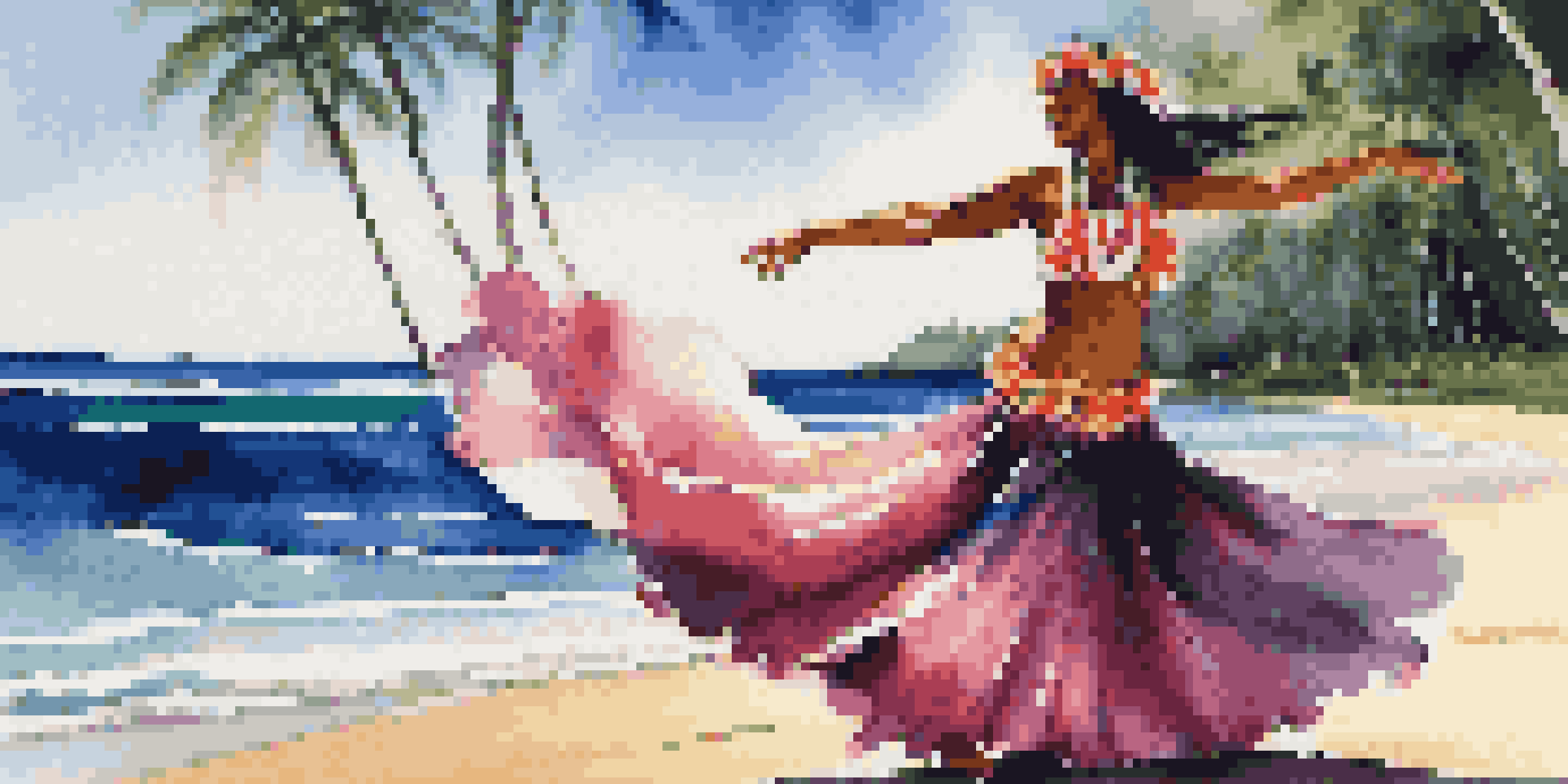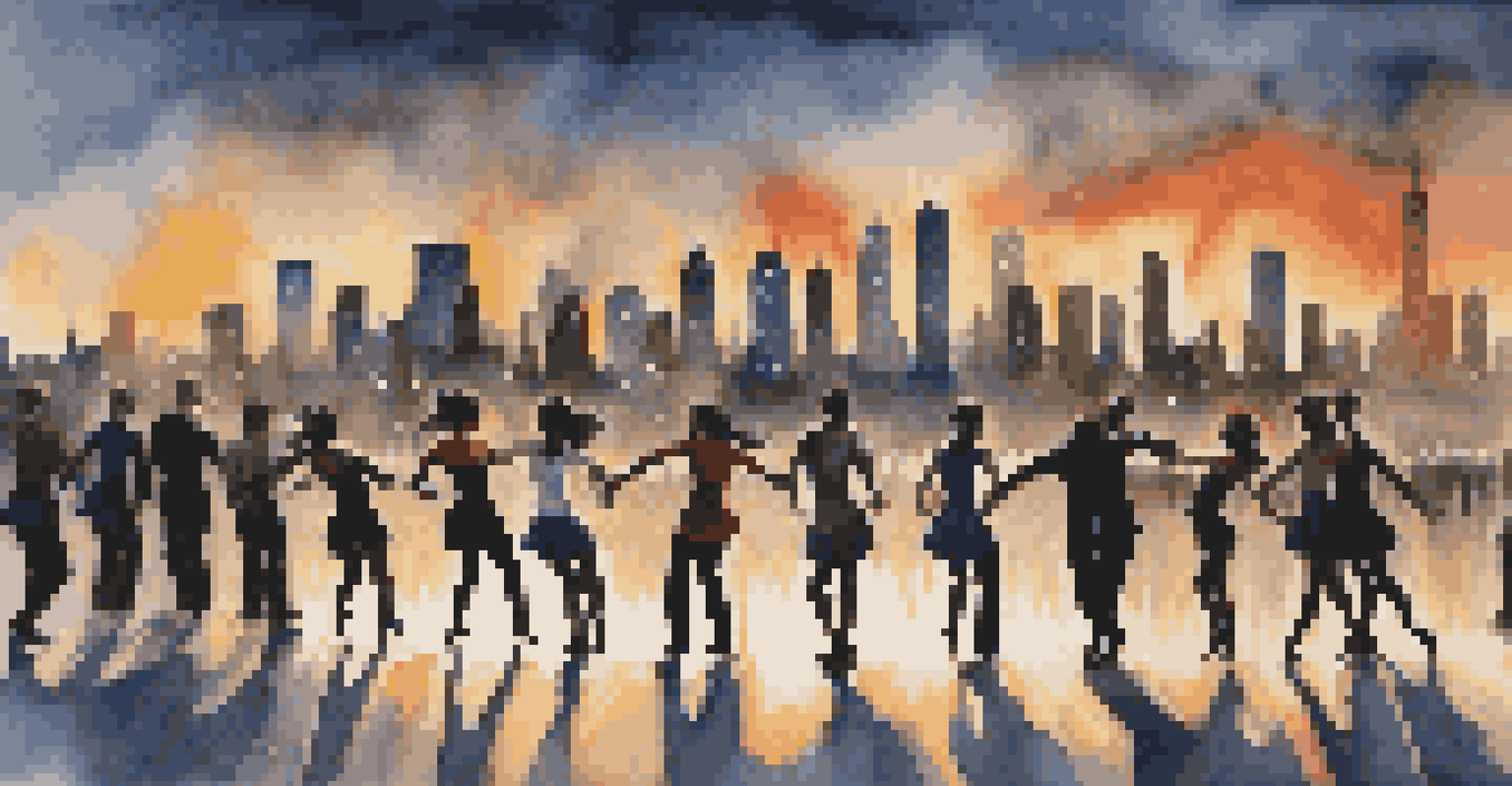Dance as Historical Documentation: Telling Stories Through Steps

The Ancient Roots of Dance as Storytelling
Dance has been a form of expression since ancient times, often intertwined with rituals and celebrations. From the tribal dances of indigenous cultures to the elaborate movements of ancient Greeks, these performances served not just as entertainment but as a means to narrate history. For example, the Hula dance of Hawaii encapsulates stories of ancestry and cultural beliefs through its fluid movements and gestures.
Dance is the hidden language of the soul.
As societies evolved, so did their dance forms, mirroring the changes in culture and tradition. Each step and rhythm can represent significant events, beliefs, or societal roles, preserving history in a way that written words sometimes cannot. This oral tradition through movement allows stories to be passed down through generations, ensuring that the essence of a culture remains vibrant.
Moreover, dance can also serve as a reflection of social dynamics and changes within a community. The way people move in dance often reveals their values, struggles, and triumphs, making it a rich source of historical documentation that scholars continue to explore today.
Dance as a Medium of Social Commentary
Throughout history, dance has not only celebrated culture but also critiqued it. Many choreographers and dancers have used their art to comment on social issues, such as inequality, war, and identity. For instance, the modern dance movement emerged in the early 20th century as a counter to classical ballet, offering a platform for personal and political expression.

A striking example can be found in the works of Martha Graham, who tackled themes of human emotion and societal constraints through her choreography. Her pieces often reflected the struggles of women and the impact of war, making them both personal and universal narratives. These dances serve as a powerful reminder that art can challenge the status quo and inspire change.
Dance as Storytelling Medium
Dance serves as a powerful medium for storytelling, preserving cultural narratives and historical events through movement.
By weaving together personal experiences with broader social themes, dance becomes a living document that captures the zeitgeist of an era. This dynamic relationship between movement and message ensures that dance remains a vital form of commentary in contemporary society.
Cultural Preservation Through Dance
Many cultures utilize dance as a method of preserving their heritage and history. Traditional dances often tell the stories of a community’s origins, struggles, and triumphs, encapsulating centuries of knowledge and experience in a few movements. For example, the Indian classical dance forms, like Bharatanatyam and Kathak, are rich with storytelling elements that convey ancient myths and legends.
Dancing is like dreaming with your feet.
These dance forms are not merely performance art; they serve as educational tools that teach new generations about their cultural identity. By participating in these dances, individuals not only learn the steps but also the stories and values behind them, creating a deep connection to their heritage. This practice ensures that the cultural narratives remain alive and relevant.
Moreover, the revival of traditional dances in the face of globalization highlights the importance of cultural preservation. Many communities are embracing their dance traditions as a way to resist cultural homogenization, reminding us that these art forms are vital to the fabric of human history.
Dance and the Evolution of Historical Narratives
As history progresses, so do the narratives that shape our understanding of the past. Dance evolves alongside these narratives, often reinterpreting them to reflect contemporary values and perspectives. For instance, many dance companies today are revisiting historical events through modern choreography, creating a bridge between past and present.
This reinterpretation allows audiences to engage with history in a dynamic way, experiencing the emotions and stories behind events like never before. A poignant example is the adaptation of classic ballets, where choreographers infuse modern themes, making the stories resonate with today’s audiences while keeping the original essence intact.
Social Commentary Through Dance
Throughout history, dance has been used as a form of social commentary, addressing issues like inequality and identity.
Through this ongoing evolution, dance not only documents history but also invites reflection and discussion about its relevance in our current society. This adaptability ensures that dance remains a powerful tool for historical storytelling, continually shaping how we perceive our collective past.
Dance as a Reflection of Identity and Community
Dance often serves as a mirror reflecting the identities of individuals and communities. Different styles and forms of dance can signify various cultural backgrounds, offering a way for people to express their unique stories. For example, hip-hop dance emerged from urban communities, encapsulating the struggles and aspirations of a generation.
Moreover, community dances foster a sense of belonging and shared history. Celebrations like traditional folk dances create a space for individuals to come together, reinforcing their cultural identity and collective memory. These gatherings not only preserve traditions but also strengthen community bonds, ensuring that stories are shared and celebrated.
As communities evolve, so does their dance, often incorporating new influences while retaining core elements. This blend of tradition and innovation allows for a rich tapestry of stories that reflect the complexities of identity in a changing world.
The Role of Dance in Global Historical Events
Dance has played a significant role in major global historical events, often serving as a form of protest or celebration. During the civil rights movement in the United States, dance became a powerful tool for expression and unity, with performances that conveyed messages of hope and resistance. These dances told stories of struggle, aspiration, and the quest for justice.
Similarly, during times of war, dance has been used to boost morale or commemorate lives lost, creating a poignant connection between movement and memory. For instance, the choreography during World War II often reflected themes of resilience, highlighting the human spirit in the face of adversity. These performances became a way to narrate the collective experience of a society under siege.
Cultural Heritage Preservation
Many cultures utilize dance to preserve their heritage, teaching new generations about their history and identity through traditional movements.
By examining dance in the context of global events, we gain insight into the emotional landscape of those times. The stories told through dance during these pivotal moments provide a unique perspective on history that complements traditional narratives.
The Future of Dance as Historical Documentation
As we look to the future, the role of dance as a form of historical documentation continues to evolve. Advances in technology, such as virtual reality and digital media, are changing how we create and share dance. These innovations allow for new forms of storytelling, making dance more accessible and engaging for wider audiences.
Moreover, contemporary choreographers are increasingly blending various dance styles with multimedia elements, creating immersive experiences that tell complex stories. This fusion not only enhances the narrative but also invites viewers to participate in the storytelling process, bridging the gap between performer and audience.

Ultimately, as society progresses, dance will undoubtedly continue to serve as a vital means of documentation, capturing the essence of our shared human experience. By embracing new forms and technologies, dance will remain a dynamic storyteller, preserving history through movement for generations to come.